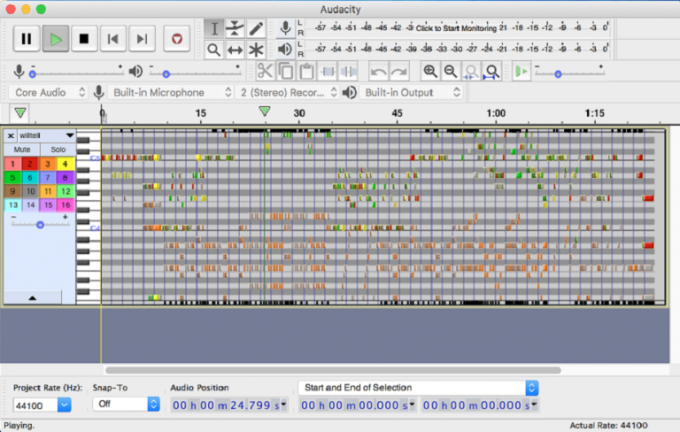- Use This Website To See What Software Runs On M1 Macs
- Download | Audacity
- See Full List On Audacityteam.org
How to Install Kali Linux on Apple Mac M1 April 9, 2021; How to Enable Auto Login in Windows 10 April 7, 2021; How to Zip a File or Folder in Windows 10 April 6, 2021; How to Install Node Js on Mac M1 March 27, 2021; How to Install Homebrew on Mac M1 March 19, 2021.NET Runtime Optimization Service High CPU Usage March 18, 2021. Dec 21, 2020 The Apple Silicon M1 System on a Chip (SOC), combined with some brilliant software from Apple, allows the new MacBook Pro to do things that no Intel-based laptop I’ve ever owned could do.

>> Go Back to AV202-B
How to Install Rosetta on Your M1 Apple Silicon Mac
Macs powered by Apple silicon, such as the M1 MacBook Pro, can run both iOS apps and Mac apps, but they can also run x86-64 software that's been built to work on Intel architecture, thanks to something called Rosetta 2.

Rosetta 2 is the translation layer that enables a Mac with Apple silicon to use apps built for an Intel-based Mac. The translation layer works in the background whenever you use an app built only for Mac computers with an Intel processor, and automatically translates the app for use with Apple silicon the first time the app is run.
There are several ways that you can learn which of your apps need Rosetta, but regardless, your Mac will ask you if you want install Rosetta the first time you try to launch an app made for Intel. Hp laserjet p2055dn automatic duplex printing.

Just click Install, then enter your username and password to allow Rosetta 2 installation to proceed. Once installation is complete, Rosetta will then be available for any of your apps that need it.
The translation process runs the first time the app is opened, and may cause the app's icon to bounce for a few seconds before it launches, but after that you likely won't see any performance hit. Indeed, in some cases, apps built with x86-64 will even run faster in Rosetta than they do on Intel Macs.
Last month, the Apple rumor mill was buzzing that the company’s long-whispered-about mixed-reality headset would be powered by the new M1 chip and, unsurprisingly, would have an outrageous price tag. A new report from the Information seems to corroborate those juicy tidbits, as well as reveal some new jaw-dropping morsels. The headset could cost as much as $3,000, sport 8K displays, and have more than a dozen cameras for hand-tracking.
The madness! The audacity! The incredible Apple-ness of it all!

Citing an unnamed source working on the project, the Information lends credence to an earlier Bloomberg report from noted Apple prognosticator Mark Gurman. The headset will purportedly have a “sleek curved visor” and will feature a type of mesh fabric. Another interesting tidbit is it might have swappable headbands, which the AirPods Max were rumored to before their launch.
According to the report, Pegatron, a Taiwanese manufacturer that also makes iPads and iPhones, has been tapped to build the product.
Use This Website To See What Software Runs On M1 Macs
Apple will purportedly use a “thimble-like device” on a user’s finger to interact with software, but it’s unclear whether that device will be included with the headset itself. The headset’s cameras are also supposed to “pass video of the real world through the visor and display it on screens” to the user, as well as track eye and hand movements. The report also claims that there will be an “outward-facing display” on the visor so users can show what they’re seeing to others.
Speaking of displays, the headset will supposedly include not one, but two 8K displays—which is mind-boggling and sounds like overkill considering most people don’t even have 8K TVs at home, not to mention the dearth of 8K content. An intriguing tidbit in the report notes that it’s possible Apple could use eye-tracking to only render the parts of the display that a user is currently looking at. Areas in a user’s peripheral vision would be rendered in lower resolutions.
Download | Audacity
The combination of an M1 chip, two 8K displays, and more than a dozen cameras could very well result in a ridiculous $3,000 price tag. That would make this headset incredibly inaccessible to the average person, given that current VR headsets like the Oculus Quest 2 retail for $300. Lego mindstorms robotics invention system 2.0 windows 7. More expensive VR headsets are around $900-$1,000, which is a third of what Apple’s might cost.
A $3,000 price tag puts this thing in the realm of Microsoft’s HoloLens 2, which as of right now is mostly an enterprise device. It also contradicts Gurman’s assertion that Apple’s goal with the headset seems to be priming consumers (and developers) for an eventual pair of smart glasses. While it’s likely that Apple doesn’t care about this headset being a commercial hit—supposedly only 180,000-250,000 are expected to sell—at this price, hardly anyone is going to handle this thing, let alone get the chance to become more familiar with the potential of AR or VR. Teri kasam 1982 songs.
See Full List On Audacityteam.org
But, as with the Apple Car, we likely have years of rumors ahead of us. The augmented reality headset could drop next year, with AR glasses in 2023.
